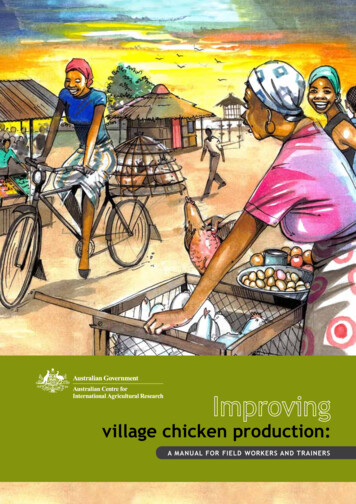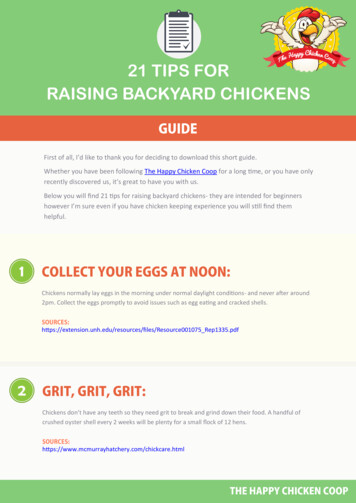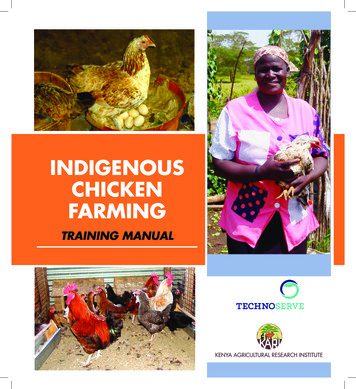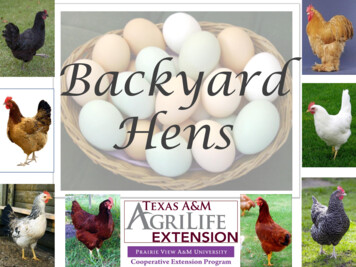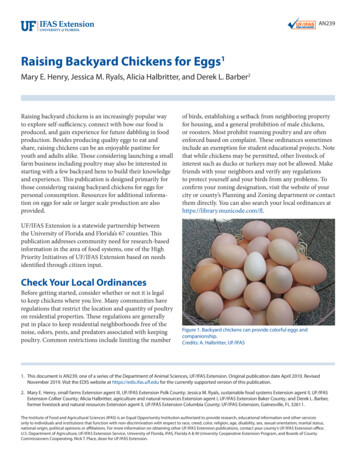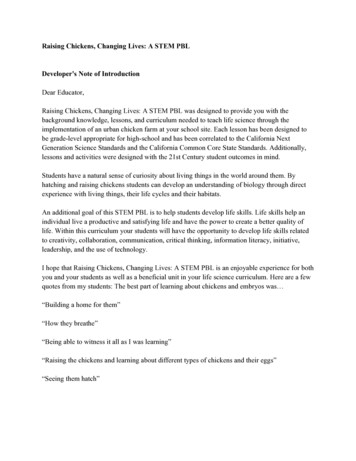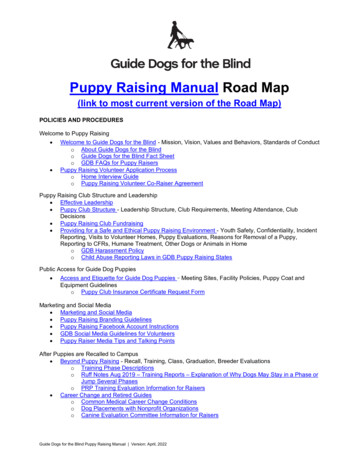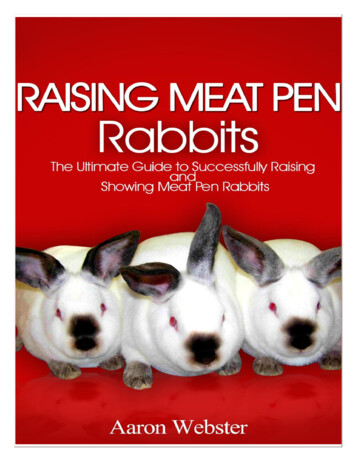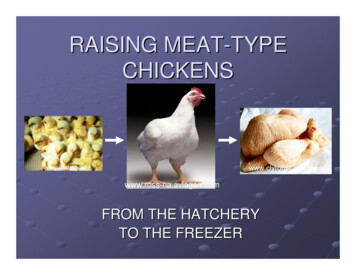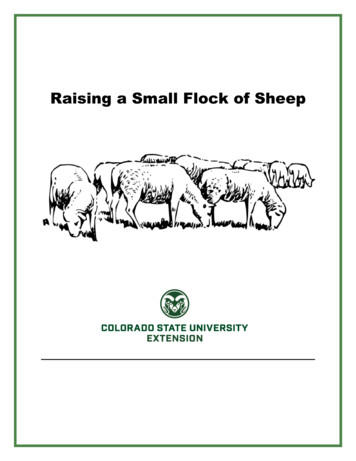
Transcription
Raising a Small Flock of Sheep
Table of -------------------3Why uction --------9The ------------------------------------------20Health ----------------------------------------21Disease and ------------------------26Handling and edator Control and --------------------------------34Wool -37Prepared byJD SextonColorado State University ExtensionandWestern Center for Integrated Resource ManagementThis manual offers production and management information about raising a small flock of sheepfor those that are interested in becoming a small flock sheep producer or for those that want tobroaden their expertise in the area of sheep production and management.2
HistorySheep production has changed drastically over the last six decades; in 1945 the totalpopulation of sheep amounted to 56 million head in the United States. On January 1, 2018, theUnited States Department of Agriculture (USDA) and the National Agriculture Statistics Service(NASS) reported all sheep and lamb inventory to be 5.23 million head in the United States.Historically, the lamb meat industry was developed as abyproduct of the wool industry. Over time, conditions in thewool industry have heavily influenced the direction of theU.S. sheep industry. Demand for wool declined after WorldWar II due to the reduction in use by military servicepersonnel (Jones G. Keithly USDA). Also, with theinvention and use of synthetic fibers and the use of othernatural fibers wool demand and use dropped dramaticallyfrom post World War II. With the decline of wool use in theUnited States so followed lamb and mutton consumption. Inthe early 1960’s per capita consumption of lamb and mutton was 4.5 pounds. Today, per capitaconsumption is 1 pound of consumption for the average American consumer.In the early 20th century sheep production was mainly focused on large sheep flocks in theWestern United States. Large bands of sheep were grazed in dry, arid environments due tosheep’s ability to thrive in less productive and harsher environments. Wool breed sheepdominated the western landscapes due to their wool quality, survivability and efficiency on highdesert ecosystems. Herders moved bands of sheep across the landscape grazing forages toproduce wool and protein.Today, sheep production has shifted to less larger flocks that dominate the numbers and to moresmaller flocks of sheep that consist of one hundred head or less. Large sheep operations still existin the western United States but we have seen an increase in small farm flock production.According to the USDA, the number of sheep operations in 2010 was 81,000. The sheepindustry, like the rest of the livestock industry is dominated by a few large operations with amajority of the animals. However, the proportion of small farmers with sheep operations is onthe rise. In 1974, 77 percent of all farms owned fewer than 100 head of sheep. By 1997, 85percent of all farms owned fewer than 100 head of sheep (Jones G. Keithly USDA). This stillholds true today as most operations in the United States raise fewer than 100 head of sheep(USDA 2018).Despite the large decreases in inventory over the past 25 years, there are reasons to be optimisticabout the future of the sheep industry. Even though sheep numbers have shown a general declineduring the past two decades, in recent years the declines have been less drastic and there haveeven been some periods of growth. Sheep are ideal for operations with small acreages and newor beginning farmers or ranchers. Growth of the industry will rely on these smaller operationsgrowing and continuing to introduce more people to the industry while at the same time tappinginto local niche markets for lamb and mutton, wool, and dairy products (USDA 2018). Over thelast couple of years, the sheep industry has seen an increase in lamb and mutton prices as well asfor high quality wool.3
Why SheepThere are many reasons to raise sheep and the reason you raise sheep is important, as your reasonwill have a significant impact on the breed(s) that you raise and the manner in which youmanage, feed and market your sheep and the products they produce. Sheep are generally easy tohandle and require less inputs and infrastructure. Sheep can offer three different sources ofincome (meat, wool, and milk). Wool and milk products can be turned into many differentproducts that can have an economic benefit to your operation. Also, the initial start up costs intosheep production is much less than other livestock enterprises. Sheep are among the mostefficient of all domesticated livestock and can adapt to the most extreme environmentalconditions. Sheep are also very good at consuming a variance of feedstuffs such as crop residue,forbs, grass, brush and weeds. Sheep are a great natural weed control and can consume certainweeds that are otherwise detrimental to other ruminant animals. Sheep have been described asthe “original greens keepers” that are highly eco friendly to the environments they are raised andgrazed in.Traditionally, sheep have been raised on farms and ranches for the purpose of generating anincome for a farm and family. While some farms make a majority of their income from raisingsheep, sheep production is very often a secondary enterprise on a farm. It is a popular enterprisefor many part-time and lifestyle farmers as well as for 4-H and FFA youth. Some people keepsheep to improve or maintain their landscapes. Due to their small size, upland grazingpreferences, and desire for a varied diet, sheep are idealfor vegetation control, especially where the primaryvegetation is grass and forbs. Their small hoovesminimize soil compaction and erosion. They shy awayfrom fragile riparian areas and are great as multi speciegrazing management tool to get the most out of anecosystem and efficiently grazing landscapes.In the last couple of years the United States has seen anincrease in ethnic groups moving into the country. This increase has boosted the sheep industryas these ethnic groups prefer to eat lamb and mutton as it is their preferred and normal diet. In1900, roughly one in eight people in the United States were a race other than White. That figurebegan to rise in 1970. By 1990, nearly one in five people were a race other than White and overthe next decade, that proportion continued to rise to one in four people.8 In coming decades, theracial composition of the population is projected to change even further, so one in threeAmericans—32 percent of the population—is projected to be a race other than White by 2060(U.S. Census Bureau 2018).There are some disadvantages to raising and producing sheep. The main disadvantage to raisingsheep is their increased chance to be subject to predation. Sheep are quite venerable and havemany natural predators such as Coyotes, Wolves, Bear, Bobcats, Mountain Lion, Eagles anddomestic dogs. Sheep operations must be very well managed due to the risk of predation,increased time and effort will have to be put forth in the management of predators to a flock ofsheep. Livestock guardian dogs or other animal defense species such as Lamas or Donkeys may4
have to be used and managed within the operation to protect the flock. Sheep are more prone tosickness and disease and a good understanding of sheep or a proper Vet Client PatientRelationship will have to be established for success in sheep production. Sheep also require morefencing compared to cattle and horses. Four strand barbwire fences will not hold sheep inpastures and also allows predators’ easy access to the flock. Woven wire and electric fence areneeded to coral sheep and to protect them which are increased costs for the beginning or newproducer. Wool is a valuable commodity that sheep produce; however, it is getting harder to findpeople that will shear sheep in the United States. Not only are you not able to harvest the wool,but wool left on sheep to long can result in heath and reproductive problems. Also, wool left onsheep to long begins to lose its quality and increases the chance for parasites.BreedsAccording to some estimates, there are more than 1,000breeds of sheep worldwide. Sheep were the first animal tobe domesticated and can be found on every continentworldwide. The American sheep Industry (ASI) recognizes60 breeds of sheep in the United States. New breeds ofsheep are being introduced to the US consistently throughimported semen, however only a handful of breeds are ofeconomic importance to the commercial industry. Manyniche breeds of sheep are being raised for their different attribute of meat, wool and milk quality.Over the last decade we have seen an increase in hair sheep in the United states. While it isestimated that hair sheep comprise only 10 percent of the world's sheep population, theirnumbers are growing, especially in temperate climates like the United States. In 2011, 21.7percent of US sheep operations owned hair sheep, compared to only 4.6 percent in 2001 and 1percent in 1996 (Sheep201). Pictures and descriptions of more than two hundred sheep breedscan be found at http://afs.okstate.edu/breeds/sheep/.Deciding which breed to raise in your operation is an important decision that each shepherd mustmake. The most appropriate breed will depend upon the environment they will be raised in,management intensity and products you plan to produce with your flock. Breeds of sheep aregenerally classified as Wool Breeds, Meat Breeds, DualPurpose Breeds and Hair Breeds.There are many wool breeds of sheep and wool breeds canbe broke down to fine wools and medium wools. Some ofthe more common fine wool breeds are Rambouillet,Merino and Debouillet. Fine wool breeds are known fortheir extremely fine wool grades and uniform fleeces. Thefine wool breeds wool is known to produce luxury clothinggarments. Fine wool is very comfortable against humanskin and can be worn to stay very warm. Popular medium wool breeds consist of Colombia,Targhee, and Corridale amongst others. These breeds wool is not as fine and as consistent as thefine wool breeds, but still produce a quality fleece. All wool breeds will be white faced sheepthat are known for their wool quality, reproductive performance and hardiness.5
Meat breeds consist of Suffolk, Hampshire, Southdown and Shropshire. These breeds are knownto be black faced and for their meat quality and growth traits. These breeds are commonlycrossed with wool breed sheep to produce market lambs. Wool from the black face breeds lacksthe fineness and length of staple and is commonly used in products such as rugs and drapery.Dual purpose breeds consist of breeds that are known forboth their meat and wool quality. The most common dualpurpose breed is the Dorset. It is a white faced sheep that hasfiner wool than that of themeat breeds and bettermeat quality than that ofthe wool breeds.Finally, hair breeds are sheep that do not have to be sheared orshed their fleeces naturally. In the United States there has beenan increase in hair sheep numbers to factors such as lack ofprofitability in the wool market, lack of sheep shearers, andtheir ability to flourish in hot dry climates. Hair Sheep are considered easy to care for and do nothave to be sheared and have a higher tolerance toBreed Images Source: OSU Sheep Breedsparasites.SelectionThe most important step in deciding what breed of sheep you should raise is to understand yourenvironment and what products you want to produce from your flock. After you have decidedwhat purpose and breed you are going to raise, selection is the next step to success within yourflock. Selection is the most important step in designing a program for your flock. Your selectiongoal should provide a clear picture of what your herd, production and marketing goals withinyour operation are. There are many different selection criteria and emphasis on certain traits willbe dictated by your operation and the management it is under. Heritability of traits in sheep isshown in Table 1. Researchers have estimated the heritability (the ability to "pass on" traits tooffspring) of the economically important traits (table 1). Generally, if the heritability estimate isless than 20 percent, progress is slow. A heritabilityestimate of 20 to 40 percent is considered medium. ASelection Criteria:heritability estimate greater than 40 percent is high- Reproductive(NMSU Sheep Production and Management).Improvement of your herd will be dictated on the- Fertilitymeasurement of the trait, records kept in the operation,- Carcass and Growthvariation of the traits, and the heritability. Each operations- Fleeceselection criteria will be different as the focus and- Dairyproduction of the operations will vary. The type of sheep- Structureoperation you are a going to operate will dictate whattraits you will focus on. Traits such as carcass or wool willbe focused on but a good shepherd will keep reproductive and fertility traits in mind at all timesas these are the traits that will dictate success in every operation. However, it is important to6
keep in mind that management and environmental factors will dictate and influence all of theseselection traits. Nutrition andenvironment are the two biggestHeritabilities of Various Sheep Traitsfactors that can affect all of theseTraitsPercentagetraits success. If sheep are not kept inReproductiveproper body condition or areEwe Fertility5environmentally stressed, these traitsProlificacyb10will be dramatically influenced in aScrotal Circumference35negative way.Crossbreeding is a common practicein the commercial sheep industry toachieve maximum production ofoffspring. Heterosis or hybrid vigorallows for superiority in desired traits.Heterosis is the difference inperformance or breedcomplementarity between thecrossbred and the averageperformance of its purebred parents.Economically important traits aregoing to depend on the individualoperation. However, selection foreconomically important traits is key togenetic improvement and long termsuccess to an operation and its bottomline. The more highly heritable a traitis will have a greater affect oneconomics and the quality of geneticsyour flock possesses. For example, ifwe look at Table 1, we can see thatfleece traits are relatively high inheritability, so a producer can selectcertain fleece traits and expect greatergenetic results than compared to someof the reproductive traits.CullingUnfortunately culling or eliminatingsheep from the herd that are notproducing is a practice that eachshepherd needs to perform. It can bedifficult, particularly in smaller flockswhere the sheep almost become partAge at PubertyLamb Survival cEwe Productivity d25520Birth weight60 day wt.90 day wt.120 day wt.240 day wt.Preweaning gainPostweaning gain15101520401525Carcass wt.Weight of trimmed retail cutsPercent trimmed retial cutsLoin eye area12th rib fatDressing percentage354540353010Greased fleece wt.Clean fleece wt.Yield (%)Staple LengthFiber eDairyMilk yield30Fat %30Protein %30Fat yield35Protein yield45a May increase to 10% in ewe lambs, in ewes lambed in the fall and inewes lambed in the spring in flocks with low fertilityb Lambs born per ewe lambingc May increase to 10% in flocks with low lamb survivald Pounds of lamb weaned per ewe exposedTable from Sheep Production Handbook; pg. 55, 2015 editionvolume 87
of the family. But, we need to keep production and costs in mind. If a sheep is not performingthan it is costing you money. Common culling reasons are poor reproductive performance,health, structure, disposition, udders, age, dystocia issues, fertility, and fleece quality. Cullingpractices in the ewe flock need to happen annually. Proper records of individual ewesperformance will assist you in making those tough decisions. If a ewe is only producing milkfrom half of her utter, she needs to be culled. If a ewes lambs are not growing compared to theircounter parts every year she needs to be culled. Culling will allow you to keep the best geneticsin your flock and by holding on to ewes that are not performing is only hurting the geneticprogress and your bottom line. Same holds true for rams, if fertility is an issue for a ram, heneeds to be culled. Also, sometimes rams become very aggressive and a safety hazard, if thishappens they need to be culled. Structural correctness is also a big culling issue. If a sheep isconstantly dealing with structural issues they need to be culled. Age is a major factor as well,with age, performance sometimes reduces, resulting in poorer performing lambs, never beingable to maintain weight and higher risk to disease and sickness. With the proper cullingpractices, the genetics and performance of your flock will increase and allow those economicallyimportant traits flourish.Production RecordsThe goal of every shepherd should be to increase production and stay sustainable along the way.Without proper production records a manager cannot monitor or track the production or thesheep flock. Not only will proper records allow you track production, but they will also assistyou in selection, flock health, fleece quality and yield, reproductive performance and culling. Allsheep need to be permanently identified through ear tags. All production dates also need to bedocumented such as breeding, birth, weaning and shearing. All performance records such as birthweights, weaning weights, 90 day and 120 day weight, and fleece yield and quality will allowyou to compare genetics and to see how the flocks’ offspring are performing as well asindividual ewes and rams. Production records are a producers best tool to advance the flockgenetically as well as have proper documentation of flock health and performance. Productionrecords are must within any operation and will pay off in the end to allow the flock to flourish.It is also important for every sheep producer to know they need to register their flock with theUSDA’s National Scrapie Irradiation Program. Scrapie is a transmissible spongiformencephalopathy (TSE) affecting sheep and goats. The presence of classical scrapie in the U.S.sheep and goat population affects industry economically through production losses, lost exports,and increased production and disposal costs. Public health concerns related to the transmission ofbovine spongiform encephalopathy (BSE) to humans have resulted in efforts to eradicate allTSEs in food-producing animals.Surveillance for scrapie in the United States is conducted through the National ScrapieEradication Program (NSEP), a cooperative State-Federal-industry program. The surveillancecomponents of the NSEP include:1. Regulatory Scrapie Slaughter Surveillance (RSSS);2. Non-slaughter surveillance (e.g., trace investigations, on-farm testing); and3. The Scrapie Free Flock Certification Program (SFCP).8
United States Department of Agriculture Animal and Plant Health Inspection ServiceThe program’s goals are to eradicate classical scrapie from the United States and to meet WorldOrganization for Animal Health (OIE) criteria for disease freedom. Since 2002, the prevalence ofscrapie has decreased significantly through existing eradication efforts, largely a result ofeffective slaughter surveillance.With this program you will be required to put a scapie ear tag with your flock identificationnumber in every intact male and female sheep you own. Sheep that you purchase from otheroperations will be given an ear tag and id number from that operation. It is unlawful to remove ascrapie tag from any sheep and the sheep will carry this tag for its entire life.Example of performance records.DateSex ofSireDamlambedlamb1/10/18 Suffolk 101R/R1/11/18 Suffolk 110E1/12/18 Dorset 201E/E/R1/12/18 Suffolk 108E/E1/13/18 Dorset202E/R1/13/18 Suffolk 107R/R1/13/18 Suffolk 103R1/14/18 Dorset 203R/R/RExample of individual ewe records.BirthtypeTWSTRTWTWTWSTREwe ID 101Scrapie IDDate of birth 1/15/15SireType of birth 2 - 2Birth weightSexoflambs1/1/16 456 E1/10/17 456 R,E1/10/18 654 R,RDateSirelambedBirthLamb 5.5,4.5 9,1810One still.12.01811Backwards5.0,6.0,5.5 1812,1813,1814221237.0BreedDamWeaning weightSuffolk32180.0TypeType ofDate WeaningofLamb IDCommentsrearingweaned weightbirth8.0SS16014/1/16827.0,7.5 TWTW 1701,1702 4/15/17 72,79.7.5,8.0 TWTW 1801,1802 4/10/18. 80,83.d.BirthweightThe InvestmentNow that you have decided on a breed of sheep and what their purpose is going to be, you nowhave to make the investment. You might already have a small flock in place and are want to9
grow, or you may be starting with nothing and need to make the initial investment to begin yoursheep enterprise.Either way you are growing to want to see if your sheep enterprise is going to cash flow and beprofitable. If you are investing your own money or loaning funds from a bank you are going towant to get some simple financial forms together such as an enterprise budget, cash flowstatement, and balance sheet.The best way to estimate the profitability of a sheep enterprise is to do an enterprise budget. Anenterprise budget is a simple listing of income and expenses based on assumptions of yourenterprise. They are useful for performing breakeven analyses and can be used to select the besttype of enterprise or a mix of enterprises for your operation. Examples of this would be doing anenterprise budget for meat and wool, or wool and milk.By performing an enterprise budget you will see if your sheep enterprise will be profitable or ifyou will have to expand or decrease your production focus. Many small flocks are not expectedto be profitable; however, if it does not create some profit, longevity of the flock may not occur.The ewe herd should be expected to sustain its self even if it is not the primary income of theowners. Profit from your sheep flock will allow you to purchase superior genetics and increasethe production of the herd. A sheep flock’s biggest expense is feed costs and loss to predators.By performing different enterprise budgets and setting up different scenarios for feed and othercosts as well as other income sources, you may just find that your sheep flock can make asubstantial profit or may never work. It is better for the enterprise budget to tell you whether itsgoing to work or not before you make the investment.The biggest expense for most sheep operations is feed costs, which has the largest effect onprofitability. Each operation is going to vary depending on location and feed resources available.Due to drought conditions in much of the western United States over the last couple of years, theindustry has seen hay and grain prices increase. An advantage to raising sheep is they are verygood at adapting to different feed sources and can be very productive on forages and feeds thatother livestock are not. Work with area producers and your local Extension Office to findcheaper sources of feed.Colorado State University Agriculture Business Management is a great resource to help assistyou with the financial and business side of your business. The Agriculture and BusinessManagement Economists are dedicated to providing extension/outreach information including: principles and concepts of production economicsColorado State University Agriculture financing methods and analysisBusiness Management and Economics investment analysis legal regulations on business activitieswww.wr.colostate.edu/ABM/ concepts of marketing and price determination issues related to estate planning10
Example Enterprise Budget for 100 ewe enterpriseFLOCK INFOPRODUCTION EXPECTATIONSNumber of ewesNumber of rams1004Percent lamb crop raisedEwe replacement rate180%20%Adult death loss3%Ram replacement rate25%INCOMENo. hdlbs/hdPriceUnitTotalPer eweMarket lambs180901.85lb 29,970 299.70Cull ewes12170 0.75lb 1,530 15.30Cull rams1200 0.40lb. 80 0.801048 0.90lb. 749 7.49 32,329 323.29WoolTOTAL INCOMEOPERATING COSTSNo. hdAmt/hdUnitCostTotalPer eweHay1040.4ton 110.00 4,576 45.76GrainSalt and minerals10410410015lblb. 0.20 0.52 2,080 811 20.80 8.11Feed for lambsPasture Lease18028410020 ac./3 monthslb.head 0.18 0.25 3,240 8,520 28.80 85.20Deworming1041dose 0.65 68 0.68Deworming (lambs)1802dose 0.55 198 1.98Vaccinations (adults)1041dose 0.50 52 0.52Vaccinations (lambs)Other vet costs1801042dosehead 0.50 2.50 180 260 1.80 5.15Shearing104head 4.50 468 4.681head 500 500 5.00Bedding104head 3.00 312 3.12Supplies104head 2.50 260 2.60Hauling162head 4.50 729 7.29 500 300 5.00 3.00Feed costsRam replacementLivestock protectionManure RemovalOther expenseFixed CostsDepreciation on Breeding EwesInterest104head5% for 6 months6.50%6766.76 576 5.76TOTAL COSTS 24,306 242.01Profit 8,023 81.2811
PurchasingNow that you have done your enterprise budget and profit is in your future, where do you buysheep? This is a common question and purchasing sheep from the right operation or person isvery important. It is becoming more difficult to find large numbers of sheep for sale. Importantfactors that you need to keep in mind as you purchase sheep are:- Flock History-Age-Immunizations given-If bred, what too-Disease and sickness issues on operation you are purchasing from-Feed they are currently on or being fed-Environment they are being raised in-If purchasing yearling rams or older, have they been through a breeding seasonOne can always go to the local auction barn and purchase sheep. However, if sheep arepurchased from an auction barn you need to use caution and research the group of sheep that youare potentially buying. Contact the seller of the sheep and find out their history and status. Askthe seller what they have been vaccinated with, the age of the sheep and what they have beencurrently eating. Also, keep in mind that when sheep are purchased at an auction barn they havebeen exposed to an abundant amount of disease and sickness. Proper evaluation and quarantinewill have to take place when the sheep are brought home to prevent any loss due to exposure ofdisease and sickness. Another avenue to purchase sheep is to talk to local producers to see if theyknow of any sheep for sale. This could be dispersals of neighboring farms or ranches or otherproducers that will have the amount of sheep you are looking for to sell. If purchasing anotheroperations dispersal, make sure that the sheep are in good health and proper animal husbandryhas occurred with the flock. Another avenue to purchase sheep is seed stock producers. Seedstock producers are in the business to sell yearling ewes, ewe lambs and aged ewes. Aged ewesfrom another producer may not be performing for the current producer, but they can be a greatstart for the first time sheep owner. When purchasing aged ewes, 3 years old or older, make sureto ask about any lambing issues such as dystocia problems, bad in the lambing jug, motheringability and general health of the ewe.One area to approach with caution is purchasing sheep from a broker that purchases sheep frommultiple operations to build numbers that a customer needs. This situation is very similar topurchasing sheep for the local auction barn. When sheep are purchased from multiple operationsand brought together you are asking for trouble. You have now exposed each flock to each onesdisease and sickness issues. Make sure that the operation or individual you are purchasing sheepfrom is someone you can trust and they provide the correct documentation and records on thesheep.Anytime a producer purchases new sheep from another operation there are proper bio-securityand quarantine protocols they should go through. Do not turn newly purchased sheep out withthe existing herd. New sheep to an operation should be quarantined or kept away from existingsheep for at least 30 days. This will allow the new sheep to break with sickness if they are going12
to and allow you to treat them properly without exposing the existing sheep to sickness anddisease.Another important thing to keep in mind is to understand your states regulations ontransportation and health requirements. Some states are a brand state for sheep just like cattle,where they require a brand inspection before sheep can be tr
many natural predators such as Coyotes, Wolves, Bear, Bobcats, Mountain Lion, Eagles and domestic dogs. Sheep operations must be very well managed due to the risk of predation, increased time an
